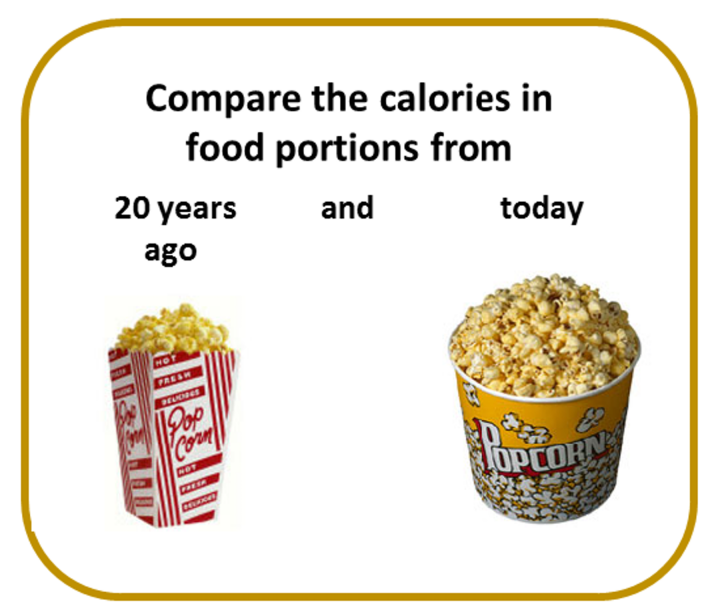We often talk about WHAT to eat, but a big part of healthy eating and weight control is HOW MUCH to eat. So, what is a serving size? And is that different than a portion size? Here’s the skinny.
What’s a “Serving Size”?
A serving size is a “standardized” amount of food that’s usually measured in ounces or cups, based on dietary guidelines. For example, a serving is one cup (eight ounces) of milk.
Of course, not many people carefully measure or weigh their food before they eat!
How is a “Portion Size” Different?
A “portion” is how much food you end up putting on your plate, whether in a restaurant, from a package, or in your own kitchen.
Sometimes the portion size and serving size are the same, but sometimes they are not.

Many foods that come as a single portion actually contain multiple servings. Average portion sizes have grown so much over the past 20 years that sometimes the plate arrives and there’s enough food for two or even three people on it!
- Many restaurants give several servings of pasta as one “portion.”
- Consider your bowl of cereal. The Nutrition Facts on the cereal box label may indicate ½ cup cereal for one serving but if you eat ¾ cup, that is your portion size.
- A 20-ounce soda has 2.5 servings in it.
- A 3-ounce bag of chips, which some would consider a single portion, contains 3 servings!
From cheeseburgers to bagels to pasta and meatballs, portions have doubled in size (or more) today.

Matching Serving to Portion
To match our servings to our portions, nutritionists have made many attempts to help us understand their recommendations, using visual cues.
One way to estimate your portion is by comparing it to something else.
- Experts have a dizzying array of pictures to help us understand the appropriate size of a serving: a hockey puck, a pair or stack of dice, a postage stamp, a checkbook, a light bulb, an iPhone, a computer mouse, a man’s wallet, a deck of cards, and any number of “balls” (e.g., billiard ball, baseball, tennis ball, ping-pong ball, golf ball).
- They’ve also used hand measurements (always available): the size of a closed fist, a thumb, a thumb-tip, a palm, a fingerprint, a handful. (Which can lead to this sort of advice: “When you’re out to eat and want a bite of your hubby’s dish, consider taking two thumb tips’ worth. That satisfies a craving…and won’t derail your diet.”)
If your mind works this way, however, the easiest comparison to estimate your portion is probably using your own hand:
- An average-sized fist is about 1 cup. This is a good portion size for raw or cooked vegetables or whole fruit.
- A scooped handful is 1/2 cup. This is about 1-ounce equivalent for grains, such as pasta, rice, and oatmeal
- The palm of your hand measures about 3 ounce-equivalents. This is an appropriate portion size for fish, chicken, beef and other meats.
Tips to Overcome Portion Distortion
Here are some tips to overcome portion distortion:
- Add vegetables first! For almost every meal, start by loading a plate with raw leafy greens and/or a variety of cooked and colorful vegetables. Add protein and grains as sides.
- Breakfast could be an omelet with sauteed vegetables (even leftover salad greens), adding an egg or two and some shredded cheese as “binders”. Alongside, a piece of whole-wheat toast and some fruit.
- Lunch might involve a large, mixed-greens salad tossed with seasoned black beans or chickpeas. Often yogurt and berries alongside.
- Dinner might start with big helpings of fresh steamed asparagus and young greens thinned from their rows (chard, mustard, beet greens, kale), and then a piece of baked fish, a large helping of red quinoa.

- Eat from a plate, not a package. Take the food out of the bag or box so you can gauge the serving size better.
- Do not use over-size plates. Sometimes today’s large dishware can give the wrong impression of a portion size.
- Identify the true serving size by looking at the Nutrition Facts label.
- When dining out, don’t mistake a larger portion as better. Think serving, not portion. Do you have enough control to stop eating multiple servings and take the rest home?
- Drink water before eating: If you drink a big glass of water before you sit down to eat, you’ll feel fuller and won’t be tempted to eat as much.
- Eat more slowly. It takes 20 minutes for your stomach to tell your brain that it’s full, so after waiting you might find that you’re no longer hungry enough for that second helping.
Bottom line, sometimes the portion size and serving size are the same, but sometimes they are not. Be aware of not only what you are eating, but how much.
Learn more












